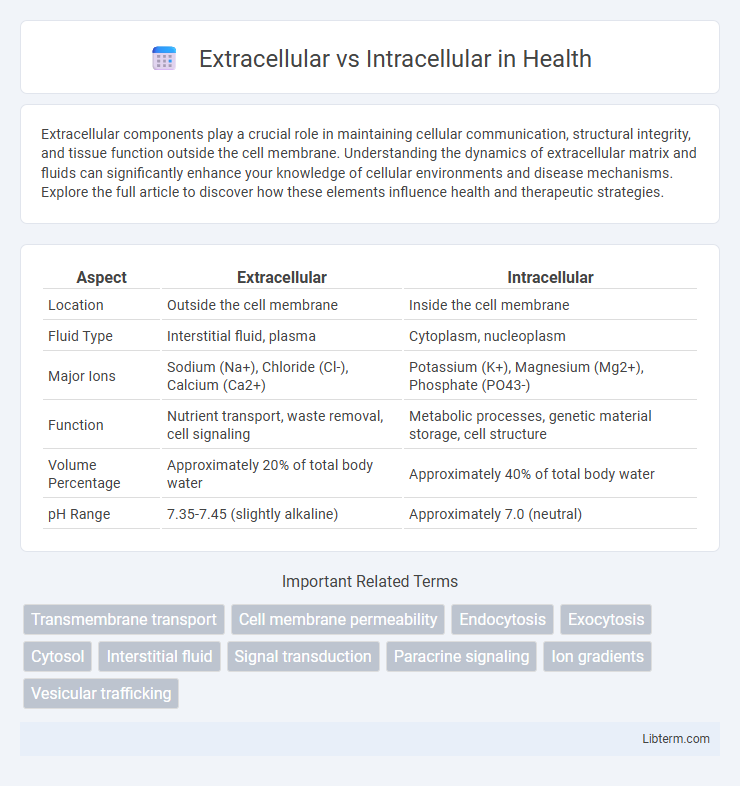Extracellular components play a crucial role in maintaining cellular communication, structural integrity, and tissue function outside the cell membrane. Understanding the dynamics of extracellular matrix and fluids can significantly enhance your knowledge of cellular environments and disease mechanisms. Explore the full article to discover how these elements influence health and therapeutic strategies.
Table of Comparison
| Aspect | Extracellular | Intracellular |
|---|---|---|
| Location | Outside the cell membrane | Inside the cell membrane |
| Fluid Type | Interstitial fluid, plasma | Cytoplasm, nucleoplasm |
| Major Ions | Sodium (Na+), Chloride (Cl-), Calcium (Ca2+) | Potassium (K+), Magnesium (Mg2+), Phosphate (PO43-) |
| Function | Nutrient transport, waste removal, cell signaling | Metabolic processes, genetic material storage, cell structure |
| Volume Percentage | Approximately 20% of total body water | Approximately 40% of total body water |
| pH Range | 7.35-7.45 (slightly alkaline) | Approximately 7.0 (neutral) |
Introduction to Extracellular and Intracellular Concepts
Extracellular and intracellular environments encompass distinct compartments within biological systems, separated by the plasma membrane, where extracellular space refers to the area outside the cell and intracellular space denotes the internal cellular milieu. The extracellular matrix provides structural support and mediates cell signaling, while intracellular components include organelles such as the nucleus, mitochondria, and cytoplasm, each essential for specific cellular functions. Understanding the dynamics and molecular interactions within extracellular and intracellular compartments is critical for insights into cell physiology, communication, and pathology.
Defining Extracellular Components
Extracellular components consist of molecules and structures located outside the cell membrane, including the extracellular matrix, interstitial fluid, and various signaling molecules that facilitate cell communication and structural support. Key extracellular matrix proteins such as collagen, elastin, and proteoglycans provide mechanical strength and elasticity while influencing cell behavior. These components create a dynamic environment essential for tissue organization, nutrient transport, and cellular interactions distinct from intracellular processes confined within the cytoplasm and organelles.
Understanding Intracellular Structures
Intracellular structures such as the nucleus, mitochondria, endoplasmic reticulum, and Golgi apparatus play essential roles in cellular function and metabolism. Understanding intracellular components involves analyzing their specific roles in protein synthesis, energy production, and cellular communication. Differences between extracellular and intracellular environments relate to molecular composition, ion concentration, and membrane permeability that regulate cell homeostasis.
Key Differences Between Extracellular and Intracellular Environments
Extracellular environments consist primarily of interstitial fluid, blood plasma, and lymph, rich in sodium ions (Na+) and low in potassium ions (K+), facilitating nutrient transport and waste removal. Intracellular environments contain high concentrations of potassium ions (K+), proteins, and organic phosphates, maintaining cellular osmotic balance and enabling metabolic processes. The key differences include ionic composition, with extracellular fluid being sodium-rich and intracellular fluid potassium-rich, and the presence of different biochemical substances critical to their distinct physiological roles.
Functions of Extracellular Space
The extracellular space facilitates nutrient transport, cellular communication, and removal of waste products, ensuring homeostasis in tissues. This environment contains extracellular matrix components like collagen and proteoglycans, which provide structural support and influence cell behavior. Furthermore, extracellular space regulates cell signaling pathways crucial for growth, immune responses, and tissue repair.
Roles of Intracellular Space in Cellular Processes
Intracellular space plays a crucial role in cellular processes by housing organelles such as the nucleus, mitochondria, and endoplasmic reticulum, which facilitate essential functions like DNA replication, energy production, and protein synthesis. This compartmentalization ensures that metabolic pathways are efficiently regulated and compartmentalized, supporting cell growth, communication, and homeostasis. Intracellular signaling pathways within this space coordinate responses to external stimuli, enabling cells to adapt to changing environments.
Communication Between Extracellular and Intracellular Domains
Communication between extracellular and intracellular domains is primarily mediated through transmembrane proteins such as receptors and ion channels, which transmit signals from the extracellular environment to intracellular signaling cascades. Ligand binding to extracellular receptor domains induces conformational changes that activate intracellular domains, triggering pathways like phosphorylation or second messenger production. This dynamic interaction ensures efficient cellular responses to external stimuli, maintaining homeostasis and regulating processes such as cell growth, immune response, and neurotransmission.
Examples of Extracellular and Intracellular Molecules
Extracellular molecules like collagen and elastin provide structural support in the extracellular matrix, while hormones such as insulin function in cell signaling outside the cell. Intracellular molecules include enzymes like DNA polymerase involved in DNA replication and proteins such as actin that maintain cytoskeletal integrity. Both extracellular and intracellular molecules are essential for cellular communication, structure, and metabolic processes.
Importance in Health and Disease
Extracellular and intracellular environments maintain distinct biochemical conditions essential for cellular function and homeostasis, with extracellular fluid facilitating nutrient transport and waste removal, while intracellular fluid supports enzymatic reactions and signal transduction. Disruptions in extracellular matrix composition or intracellular ion balance can lead to pathological states such as cancer metastasis, neurodegenerative disorders, and chronic inflammation. Precise regulation of these compartments is critical for immune responses, tissue repair, and maintaining cellular integrity in health and disease.
Future Perspectives on Extracellular and Intracellular Research
Future perspectives on extracellular and intracellular research emphasize the integration of advanced imaging techniques and molecular profiling to unravel complex cellular communication and signaling pathways. Innovations in single-cell analysis and extracellular vesicle characterization are poised to enhance targeted drug delivery and personalized medicine. Emerging technologies will drive cross-disciplinary approaches, enabling precise manipulation of intracellular environments and extracellular matrices for therapeutic breakthroughs.
Extracellular Infographic

 libterm.com
libterm.com